Post-processing and machine learning techniques add abundant value
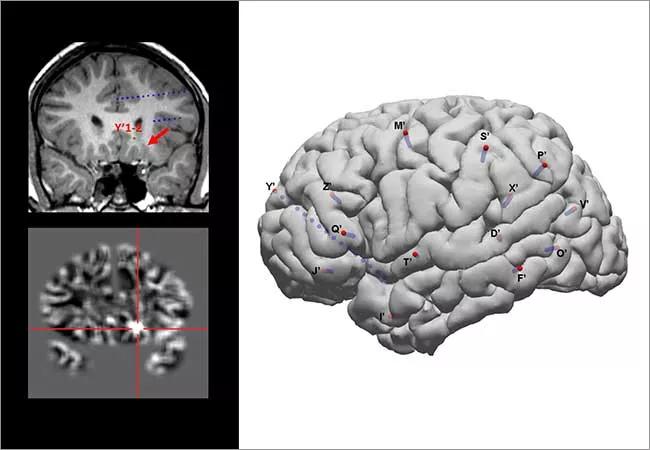
By Z. Irene Wang, PhD, and Stephen E. Jones, MD, PhD
Advertisement
Cleveland Clinic is a non-profit academic medical center. Advertising on our site helps support our mission. We do not endorse non-Cleveland Clinic products or services. Policy
In January 2017, an 11-year-old girl was evaluated for possible epilepsy surgery to treat seizures she had endured since 18 months of age. The seizures had become unresponsive to medications over the years, prompting her family to come to Cleveland Clinic’s Epilepsy Center to consider surgical options.
Her seizures occurred multiple times per day and lasted about 15 to 30 seconds each. Video EEG during her noninvasive evaluation showed that 90 percent of interictal epileptiform discharges arose from the left frontocentral region; the remainder were multiregional benign focal epileptiform discharge (BFED)-like discharges in the centroparietal (left > right) and left occipital regions.
MRI was initially read as negative, but voxel-based morphometric post-processing of the MRI revealed a subtle blurring of the gray-white junction in the left orbitofrontal region, with transmantle tracking to the lateral ventricle (Figure 1, A and B). The subtle abnormality, suspected to be focal cortical dysplasia (FCD), was then confirmed by expert visual review at a multidisciplinary patient management conference.
FDG-PET revealed bitemporal as well as left orbitofrontal hypometabolism (Figure 1C). MEG showed a tight cluster of highly consistent horizontally oriented dipoles around the left postcentral gyrus, with EEG correlates showing the left-sided BFEDs captured on video EEG; this finding was thus attributed to BFEDs unrelated to the patient’s clinical epilepsy. During her video EEG admission, she had multiple typical seizures, and ictal SPECT with 12-second injection time showed hyperperfusion in the left orbitofrontal (Figure 1D), anterior insular and lateral frontal regions.
Advertisement
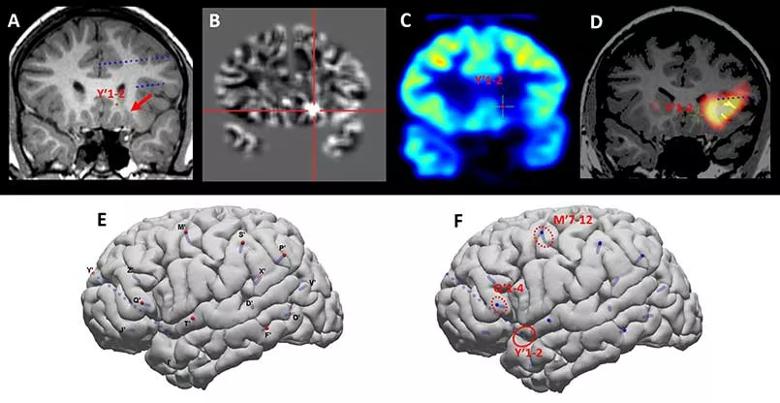
Figure 1. Presurgical evaluation results for the 11-year-old case patient in whom voxel-based morphometric MRI post-processing identified a subtle focal cortical dysplasia lesion. (A) Coronal T1-weighted MRI that served as the input to the MRI post-processing. (B) Gray-white junction image as the output of the MRI post-processing. The subtle abnormality is highlighted at the crosshairs, which corresponds to the arrow in panel A. (C) FDG-PET image showing hypometabolism involving the left orbitofrontal region. (D) Ictal SPECT localization showing hyperperfusion involving the left orbitofrontal region. (E) Map of SEEG implantation in the patient. Implanted electrodes are shown in blue, with entry points shown in red. A depth electrode (Y’) was implanted to specifically target the subtle lesion on the MRI. (F) Ictal finding on SEEG during one of the patient’s habitual seizures. The solid red circle indicates the ictal onset at the most mesial contacts of the Y’ electrode (Y’1-2). The dashed red circles indicate the early spread to the left insular (Q’1-4) and left middle frontal (M’7-12) regions. The spread to the left middle frontal region can explain the patient’s semiology of eye movement. Location of the ictal onset contacts Y’1-2 is also reflected in panels A, C and D, showing that the SEEG results were highly consistent with the structural lesion.
Based on these findings, the patient management conference panel concluded the epilepsy likely arose from the left orbitofrontal region where the subtle lesion was located. However, because the patient had unusual eye movements and eye-blinking semiology at seizure onset, the panel recommended exploration of the left frontoparietal networks (lateral and medial) as well as the left anterior insula and left inferior parietal lobule. To explore these regions, intracranial evaluation with stereoelectroencephalography (SEEG) was recommended.
Advertisement
SEEG evaluation with 14 electrodes in the left hemisphere (Figure 1E) confirmed an epileptogenic zone in the left orbitofrontal region (orbital gyrus/olfactory sulcus) that coincided with the MRI abnormality, with an epileptic network including the left orbitofrontal region, left anterior insula/frontal operculum and left middle frontal gyrus that was responsible for her clinical seizures. Twenty-six seizures were captured, and they demonstrated her highly stereotyped semiology of eye movements. They were also highly consistent electrographically. Ictal onset was seen at the electrode contacts at the MRI lesion, and clinical onset occurred only after the seizure had spread to the middle frontal gyrus (where the frontal eye fields reside), explaining the semiology of eye movements (Figure 1F).
At a subsequent patient management conference, the panel agreed that the epileptogenic zone was localized to the orbital gyrus, with early spread to the adjacent frontal operculum and anterior insula, followed by spread to the frontal eye fields. The group felt the patient was a good candidate for surgical resection of the left orbital gyrus. She and her family agreed to proceed, and she underwent resective surgery the next day, with the surgical specimen confirming FCD. The patient has been seizure-free through one year of follow-up. Significant improvement has been noted in her memory, concentration and reading.
This case illustrates the crucial role that noninvasive imaging techniques can play in the presurgical evaluation to increase the number of patients who can be offered potentially curative epilepsy surgery. Challenges of seizure localization are well recognized in the setting of medically intractable focal epilepsy with the apparent absence of a lesion on MRI. Use of high-resolution MRI equipped with computer-assisted post-processing has the potential to enhance subtle lesion characteristics and make them more easily detectable. Knowing the exact location of the subtle lesion before intracranial EEG can substantially optimize the implantation scheme by enabling a more focused surgical hypothesis, as highlighted in this case. In selected other cases where there is greater concordance among semiology, imaging and electrophysiology, intracranial EEG can potentially be omitted.
Advertisement
Several years ago, our Epilepsy Center research group published a study showing that the main pathology in nonlesional epilepsy is FCD.1 These lesions are usually characterized by subtle MRI features and can be difficult to identify by visual analysis of 3T MRI scans. Our group performed well-designed studies to validate the usefulness of a voxel-based morphometric analysis program for detection of subtle FCD.2,3 Our published studies provided validation of the morphometric analysis methods, which has enabled us to integrate them into the routine presurgical evaluation of patients with MRI-negative medically intractable epilepsies at Cleveland Clinic. With minimal extra cost and no additional tests for the patient, this process has shed light on many difficult cases, both pediatric and adult, like the one profiled here.
The advent of artificial intelligence and machine learning is revolutionizing the way large volumes of patient data are interpreted. Scientists in Cleveland Clinic’s Neurological Institute are devoting substantial efforts to using machine learning algorithms to inform the way epileptic lesions are detected and delineated.4 Although still under active development, this approach has shown great promise in automatically detecting epileptic lesions on MRI (Figure 2).
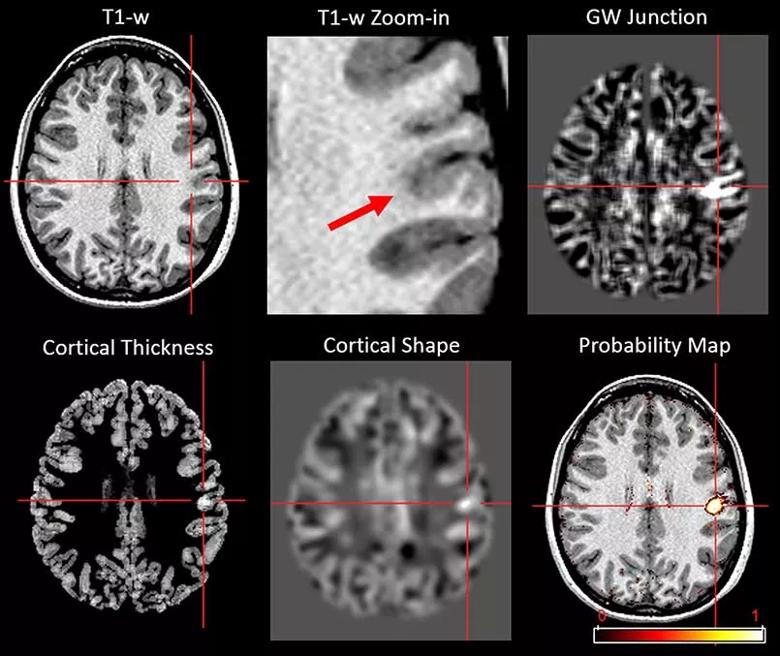
Figure 2. Images showing multiple cortical features (gray-white [GW] junction, cortical thickness and cortical shape) generated by morphometric post-processing based on T1-weighted images from a different patient with histologically confirmed focal cortical dysplasia (FCD) type IIb. Z-score maps of the three cortical features were fed into a neural network classifier that was trained on 90 patients with histologically confirmed FCD and 350 controls. The classifier generated a probability map (lower right panel) that shows successful automated lesion detection.
Advertisement
Dr. Wang is a staff scientist in Cleveland Clinic’s Epilepsy Center and joint staff in the Department of Biomedical Engineering, Cleveland Clinic Lerner Research Institute.
Dr. Jones is a staff neuroradiologist and vice chairman for research and academic affairs in Cleveland Clinic’s Imaging Institute.
Advertisement

Quick and aggressive responses to multiple complications have led to remarkable recovery
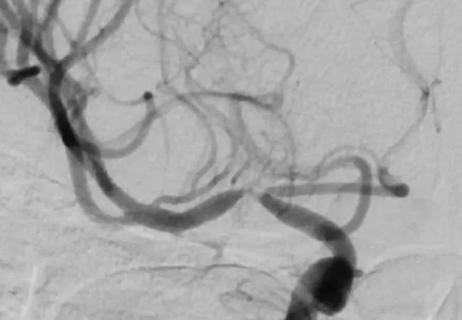
When specialized surgery makes sense for moyamoya syndrome

Multilevel cervical fusion restores function in an athletic 78-year-old

Case study underscores the imperative for thorough evaluation with SEEG
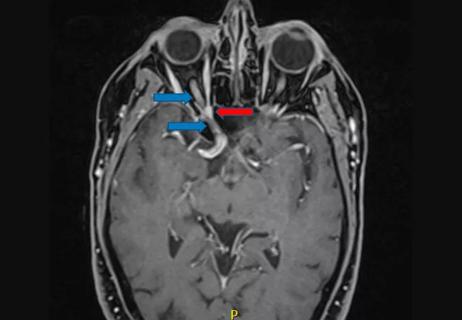
Schwannoma of the lacrimal nerve threatened right eye blindness

Case report demonstrates utility in a brain-injured patient

Partial resection plus radiation leads to good outcome from an unpredictable tumor

Diagnosis and treatment of rotational vertebrobasilar insufficiency syndrome